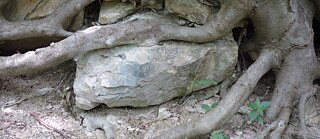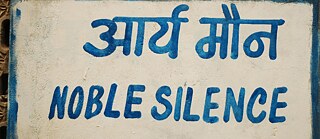A Conversation With a Stone
Strength Lies in Tranquility
They are millions of years old. Pure presence, simply there. Stones. They are mute, and at the same time, can tell an infinite number of stories as witnesses of bygone eras. Hardly anything symbolizes standstill more than a stone. They rest powerfully in a world driven by speed, haste, and a “keep it up” mentality. But are they really still? Erdmuthe Hacken had a talk with a stone to find out.
In our hectic world, “solid as a rock” immediately comes to mind when I think of you. Does this cliché bother you?
Not at all. It’s true, although strictly speaking that rock is my big brother. But of course, we have the same genes. That’s why the image you describe, which has long been a common saying among humans, is pretty accurate to our DNA. In the midst of constant motion, we stoically and unflinchingly defy all the odds. It doesn’t matter how big or small we are or what family we come from. For outsiders, this can indeed be very reassuring.
But not for you?
It’s a tad monotonous for me at times. This routine of doing nothing. Imagine everything bouncing off you. Just being there all the time. No movement. No headway. No influence. Nothing.
It’s no wonder that we stones are often used as metaphors for eternity and continuity.
Well, that’s not always the case.
True. Of course, we’re also on the move. Boulders, for example, have taken long journeys. Simply pushed here from another region.
And we’re also influenced. By nature, for example. Tides, wind, and water shape us constantly.
My cousins, the pebbles, are a fine example of this. They owe their lovely shape to rivers, streams, and oceans. Constant movement has polished them until they became round. Interestingly, they were rarely formed where they’re found. On the contrary, they often have a long journey behind them, too. So actually, they’re the opposite of eternal and steady.
Did you know that pebbles aren’t only found on Earth? They are also said to be present on Mars. And recently, I learned that round pebbles have even been spotted on the surface of Saturn’s moon Titan. Isn’t that exciting?
Absolutely. I can go into raptures with you.
Not only raptures. We’re also good for philosophizing. Just think of walks in the forest or on the beach. Sooner or later, everyone collects us. Or observes us and the waves as they ripple about us. It’s easy to start thinking about the big picture and its transience, about space and time and the existence in between.
In many cultures, we’re consequently thought of as immortal, imperishable, eternal. But we also stand for inner cohesion, indestructibility, stability, durability, reliability.
But speaking of water: You certainly also initiate movement.
Indeed. If you throw me into a (supposedly) still lake, I create waves that expand in all directions. I’m always fascinated by this contrast.
So, we could say there’s a force emanating from you.
Absolutely. I am there, I am pure existence. And at the same time, I initiate any number of things. Perhaps this also has something to do with your saying, “Strength lies in tranquility.”
Or rather in your calming effect?
You mean power that’s not expressed through movement but through healing like with healing stones.
But it also applies to consolation?
Right. Many of my companions give comfort. You can observe this particularly well in cemeteries. When time ends, eternity begins. And memorial stones and gravestones are emblematic of this. When visiting a grave, it’s customary for relatives to place a small stone on the gravestone. In this way, they show that the deceased has not been forgotten. I think that’s a wonderful gesture.
But we also have an actual comforting effect beyond mourning. Please touch me deliberately. Can you feel my cool, smooth surface?
Your cool beauty inspires creatives from a wide range of industries.
Thank you for the compliment. You’re probably thinking of stonemasons or sculptors. But that’s only natural. After all, both had a hand in the most important artistic creations, such as the ancient Seven Wonders of the World. Isn’t it wonderful that today everything having to do with gemstones — like cutting, engraving, and setting them — is a recognized occupation? And it goes far beyond jewellery. Just take furniture design or garden design. It’s hard to imagine everyday life without us. Houses, streets, walls — stones play an important role in them all.
And not only in the present day.
We served as landmarks for centuries, especially in inaccessible mountain regions. At mountain passes, we were piled up into simple cairns and made into path markers.
Speaking of history: You’ve experienced and seen so much.
Yes, we stones can tell stories. At the same time, we depict history, record it. After all, we already have a few million years behind us. In a way, we’re the original inhabitants of our earth — and thus, its oldest witnesses. Just think of cave writings or ancient stone tablets. Another example is walls — the old boundaries of farms and gardens. The stone that was built into them often has a long tradition and has seen a lot. In this context, a quote from Goethe comes to mind that I particularly like: “Stones are mute teachers; they silence the observer, and the most valuable lesson we learn from them we cannot communicate.”
While we’re on the subject of history: Could you briefly go over your résumé?
Of course. We’re a product of nature. Created over the course of millions of years. The oldest of us are up to 3.8 million years old. The word “stone,” by the way, comes from the Indo-Germanic root “stai,” which means “to coagulate,” “to condense,” “to become solid.”
Do you ever feel lonely?
Absolutely not. Look around you: My family is everywhere. My cousins alone, the pebbles, they like to show up in large groups. And as a bachelor, I am supposedly alone here, but if you look closely, I always have company. Moss is actually my constant companion. And tree roots also feel quite at home with me.
Let’s return to the metaphor of eternity and consistency. Many people also associate negative things with you. Like the expression “a heart of stone.”
The heart of stone originally comes from the Bible. In today’s context, I think it’s more a symbol of hard-heartedness or insensitivity. I think that we’re a symbol of hardness simply because of our consistency. That’s probably why we have a reinforcing effect in certain German word combinations, such as “steinhart,” “steinalt,” or “steinreich.”
After this very enlightening conversation, I’d say that you don’t really have much to do with standstill at all. But I have one more question: Some say standstill is regression — how do you react to that?
Just with a tired smile. Look at me, my fullness, my life! Is this regression?






